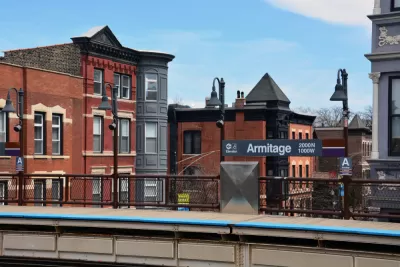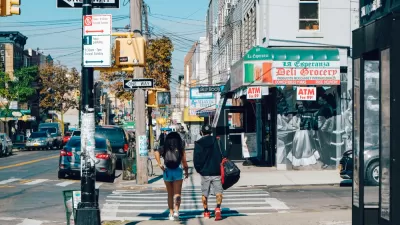The following excerpt, written by Daniel Kay Hertz in the introduction to The Battle of Lincoln Park, challenges assumptions about the forces of gentrification in Chicago, with lessons for communities around the country.

The Battle of Lincoln Park was published by Belt Publishing on October 16, 2018. This excerpt is reprinted with permission from the author and the publisher.
In December 1969, Stephen Shamberg resigned as president of one of the most powerful neighborhood organizations in Chicago, the Lincoln Park Conservation Association. His letter of resignation carried a blunt message for the people he had been leading.
“We are assisting,” he wrote, “in the destruction of our community.”
For fifteen years, LPCA had fought to transform its piece of the city’s North Side, just two miles from downtown on the shores of Lake Michigan. And indeed, Lincoln Park had been transformed. Dilapidated homes boasted new windows and paint; developers clamored to invest where banks had refused to lend; and new businesses were opening. But its members were not feeling triumphant. Instead, they found themselves bitterly divided: Some feared their decades of work might soon be rolled back. Others believed it deserved to be.
Back in the 1940s, when the antique dealers, historians, and lawyers were just beginning their campaign to restore Lincoln Park’s Victorian-era grandeur, they had felt no such ambiguity. Back then, the stakes had seemed very different to them, their campaign to remake the neighborhood almost utopian.
In the years after World War II, Lincoln Park was an aging neighborhood of walkup apartments, the lake on one side and an industrial riverfront on the other. Close to downtown Chicago, and even closer to the elite Gold Coast area, its residents’ incomes ranked sixtieth out of the city’s seventy-five neighborhoods. Despite a notable lack of racial integration—more than ninety-eight percent of Lincoln Parkers were white—almost the entire neighborhood was “redlined,” or cut off from home loans for purchases or renovations, a type of disinvestment often targeted at black communities. Home to more than 100,000 people, busy commercial streetscapes, and longstanding religious and ethnic communities, most members of the white middle class nevertheless believed it was a neighborhood without a future. For them, Lincoln Park was destined for further economic decline, perhaps even racial integration from the small black community to the south—and, if things could not be turned around, annihilation through government-led “slum clearance.”
At the same time, a small but growing movement of white professionals viewed Lincoln Park as a gem waiting to be polished and reclaimed. In the late 1800s, families of means had built stately brick homes and apartments on the rubble of the Great Fire of 1871, before ultimately abandoning them in the march towards the suburbs. Now postwar “rehabbers”—generally professional-class white homeowners who bought and renovated old homes—cited that history as proof Lincoln Park deserved a more illustrious future. If they fixed up the old homes and modernized nearby streets and storefronts, they insisted, Lincoln Park might enjoy every advantage of a new suburban subdivision—with all the history, culture, and convenience of the city. Its future might not be decline and demolition, but rebirth as a new kind of community that combined the best of both worlds.
By 1969, things had changed. People no longer wondered whether middle-class white people might settle down in an old urban neighborhood like Lincoln Park: It had already happened, and much of the eastern side of the community was now well above citywide averages in income and education. The new question was whether they would leave room for anyone else. As incomes rose, so did rents; each home renovation—increasingly performed by professional investors as much as individual families—raised property values. Meanwhile, the urban renewal program LPCA had lobbied for had demolished entire streetscapes, displacing thousands of people who were disproportionately low-income, Latino, or black.
Many now wondered if the future of Lincoln Park was the social homogeneity of the suburbs transplanted to the urban core. Shamberg was not alone in questioning whether the movement he led might be ruining the neighborhood it had meant to save.
***
The rehabbers’ path from idealism in the 1940s and 1950s to existential crisis in the late 1960s and early 1970s paralleled Lincoln Park’s path from a predominantly working class neighborhood to one of the wealthiest communities in the Chicago area. Today, Lincoln Park represents the heart of a predominantly white zone of concentrated affluence that encompasses more than half a million people over a large part of Chicago’s North Side. And just as the twentieth century history of redlining, white flight, and racist violence helps us understand why cities like Chicago have large, disproportionately black and Latino areas of disinvestment, the twentieth century history of slumming, conservation movements, and rehabbing helps explain why we have large, predominantly white, areas of concentrated investment.
Much of Lincoln Park’s path in the years after World War Two seems familiar to people who live in gentrifying neighborhoods now—from the way that new middle-class residents praised the neighborhood’s authenticity and diversity, to complaints about commercialization, to the organizing taken up by lower-income residents and their allies to preserve their place in the neighborhood. If we recognize ourselves and our neighborhoods today in the earlier experiences of Lincoln Park, we may have a better sense of where we are going, and why.
The Battle of Lincoln Park makes several arguments about gentrification in Chicago.
First, it argues that gentrification is a much older process than we often assume, with roots stretching back nearly to the beginning of the twentieth century. Short memories about the trend of increasing affluence on the North Side seem to be almost as old: Between the 1930s and 1960s, Chicago media published articles every few years claiming to have discovered a “rebirth” in Lincoln Park, few of which acknowledged earlier versions of the same story. Many of these articles are remarkably similar to those published today about the communities currently undergoing similar changes.
This long history is not just a curiosity. The consistent growth of a relatively affluent, predominantly white area on the North Side for more than seventy-five years challenges many of the most commonly offered explanations for gentrification today. These explanations—which hinge on new developments like a post-recession economy or the consumer preferences of the millennial generation—may very well shape the path of neighborhood change. But if the underlying trend predates them by the better part of a century, they cannot be the whole story.
Second, growing wealth in parts of central Chicago cannot be separated from growing disinvestment in other neighborhoods. These opposite paths are not contradictions, or a “tale of two cities.” Lincoln Park’s evolution into an affluent community does not make sense except in the context of the growing poverty—and growing black and Latino population—in much of the rest of Chicago. White middle-class residents responded to the threat of economic decline and loss of racial majority status by concentrating their investments in a tightly drawn, slowly expanding circle centered on already-established strongholds of the upper middle class. It was this concentration that both bid up housing prices and segregated professional whites within the circle, while withdrawing investments from areas outside it.
This also means that disinvestment and concentrated investment, suburban flight and gentrification have all been happening simultaneously since the early twentieth century. The simpler story—that Chicago, like many other American cities, had a distinct period of economic decline as whites fled for the suburbs after World War II and then a distinct period of resurgence as young people returned to the city in the 1990s and afterwards—covers up a much more complicated reality. Lincoln Parkers created a template for the white middle class revival of urban neighborhoods even as suburbanization reached a fever pitch. In fact, between 1950 and 1970, both trends existed within Lincoln Park itself, with much of its western side becoming deeply disinvested while its eastern side became significantly wealthier.
Third, neighborhood change in Lincoln Park was not mainly the result of individuals’ actions, but of economic, political, and social systems. Many people worked very hard to make Lincoln Park a predominantly white, middle-class community—but so did many others in neighborhoods across the city. Most of them failed. The rehabbers in Lincoln Park were successful not because of their special ingenuity, but because of their position in interlocking social, political, and economic systems, including ongoing efforts to segregate black Chicagoans on the South and West Sides, as well as the combination of happenstance and public policy that created a permanent stronghold of the wealthy in the Gold Coast just south of Lincoln Park in the previous generation.
Finally, this story shows how neighborhood change leads residents to compete over who has the authority to speak for and define their community—but also the limits of that authority. Many Lincoln Parkers who did not belong to the rehabbing movement, of course, did not feel that their neighborhood needed “saving” by relative newcomers. These residents, who tended to have lived in the area longer, have lower incomes, or both, argued they had the right to speak for the neighborhood because of their deeper roots in the area and greater numbers.
The middle class homeowners who organized to “conserve” Lincoln Park justified their role as stewards of the neighborhood with a different narrative. In their telling, they were the only people with the vision, skills, and resources to triumphantly restore Lincoln Park’s authentic identity—its Victorian-era status as a predominantly middle-class community. This narrative played a powerful role in the first decades of the rehabbing movement, giving relative newcomers to the area a sense of confidence and unity of purpose in reshaping the neighborhood.
Their confidence (if not their movement) was eventually broken, however, by sustained organizing on the part of residents who opposed the rehabbers’ changes. These challenges split the rehabbers in two, as even some former leaders came to believe that the moral authority to chart the future of Lincoln Park belonged to their opponents.
And yet even with such public defections, those who wanted to put the brakes on Lincoln Park’s evolution into an exclusive, high-income community found it difficult to do so. Moral authority was not a substitute for economic, social, or political power. As government-led demolitions and private renovations evicted thousands from the neighborhood—and some rehabbers increasingly viewed their opposition as a threat to the new Lincoln Park they had built—the battle became more desperate. Petitions and counter-petitions gave way to smashed windows, bombings, and death threats. Out of this battle, modern Lincoln Park was born.
Daniel Kay Hertz is an urban issues writer, Chicago native, and graduate of Harvard and the University of Chicago. Hertz has written about urban issues for a number of outlets, including City Observatory, The Atlantic, Chicago Magazine, South Side Weekly, and the Chicago Reader.

Planetizen Federal Action Tracker
A weekly monitor of how Trump’s orders and actions are impacting planners and planning in America.

Maui's Vacation Rental Debate Turns Ugly
Verbal attacks, misinformation campaigns and fistfights plague a high-stakes debate to convert thousands of vacation rentals into long-term housing.

Restaurant Patios Were a Pandemic Win — Why Were They so Hard to Keep?
Social distancing requirements and changes in travel patterns prompted cities to pilot new uses for street and sidewalk space. Then it got complicated.

In California Battle of Housing vs. Environment, Housing Just Won
A new state law significantly limits the power of CEQA, an environmental review law that served as a powerful tool for blocking new development.

Boulder Eliminates Parking Minimums Citywide
Officials estimate the cost of building a single underground parking space at up to $100,000.

Orange County, Florida Adopts Largest US “Sprawl Repair” Code
The ‘Orange Code’ seeks to rectify decades of sprawl-inducing, car-oriented development.
Urban Design for Planners 1: Software Tools
This six-course series explores essential urban design concepts using open source software and equips planners with the tools they need to participate fully in the urban design process.
Planning for Universal Design
Learn the tools for implementing Universal Design in planning regulations.
Heyer Gruel & Associates PA
JM Goldson LLC
Custer County Colorado
City of Camden Redevelopment Agency
City of Astoria
Transportation Research & Education Center (TREC) at Portland State University
Jefferson Parish Government
Camden Redevelopment Agency
City of Claremont





























